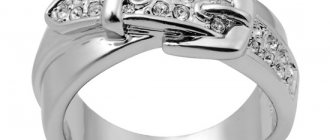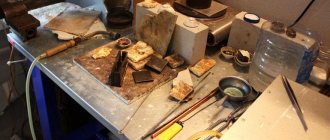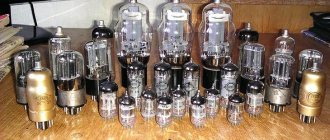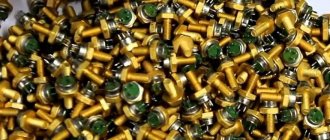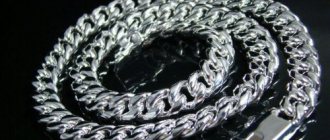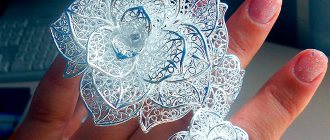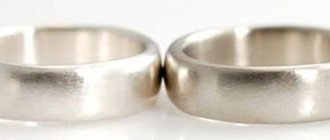Where is silver found?
The largest amount of technical silver can be found in old Soviet equipment. Of course, it is present in modern parts, but less and not as pure as in Soviet ones.
In those days, devices containing precious metals were strictly registered, and after being written off, they were transferred to a special commission. Today, the owner of these devices and equipment can directly seize and sell silver-containing RECs.
There are several sources that contain technical silver:
• wire, plates, contacts, microcircuits, relays; • housings, frames; • switches, connectors; • photographic films, x-rays; • batteries; • aviation wires.
Sources of scrap silver
Practice shows that technical silver and silver alloys are concentrated in certain products and materials that anyone can obtain. The main objects are:
- wire, contacts and contact plates;
- housings and frames of electronic devices;
- switches and connectors;
- batteries;
- X-ray films;
- various aviation parts and wires.
It is noted that in the manufacture of these materials and parts, pure silver, usually 999 fine, was used. This is due to the fact that it is this kind of silver that has high technical characteristics in terms of electrical and thermal conductivity.
Currently, any owner has the right to seize parts containing silver and sell them at his own discretion. In this case, a gram of technical silver is evaluated in relation to the entire weight.
Rhodium plated silver
In Soviet times, silver mixed with radioactive metals was used for military equipment.
They are very persistent and remain in the composition for a long time, but can harm human health. A special type of technical silver coated with rhodium is called “rhodium plated silver”. It is a highly toxic and radioactive metal that was smelted illegally. But over time they stopped producing it. When mining or buying scrap silver, you should be careful not to get a burn or any other reaction to such an alloy.
Price
The price of technical silver per gram depends on certain factors, including:
- concentration of pure silver in the alloy;
- a place where metal is sold.
To determine the metal sample, specialist appraisers are usually contacted. As a rule, they are available in most pawn shops.
Places of sale include increasingly popular online auctions. Due to the fact that the price per gram of technical silver sold there is higher than in pawn shops.
How to identify silver
In order to independently determine silver, you can use the following methods:
1. Place a piece of the alloy to be determined in a drop of nitric acid; if smoke comes out, then the alloy contains silver. To make it precipitate, you need to add salt. 2. A solution of sodium bichromate and nitric acid in equal quantities, getting on the metal, changes color - turns red. This indicates a high silver content in the alloy.
Using these methods, you can easily determine whether the resulting alloy is valuable.
Refining
The extraction of silver from silver-containing elements is carried out through refining (a set of technological measures to obtain pure silver). There are three methods for extracting technical silver, the use of which depends on the source materials and production volumes:
- cupellation;
- chemical method;
- electrolytic method.
Electrolytic method (refining by electrolysis). When using it you can achieve very good results. However, industrial silver scrap must contain a high concentration (more than 80 percent).
The cupellation method is usually used when the alloy contains low-grade silver. It is a chemical process using lead and a refining furnace. With this method, separating silver from other valuable metals is impossible.
The chemical method is used by exposing scrap industrial silver to various aggressive chemicals, which leads to the release of silver particles into sediment.
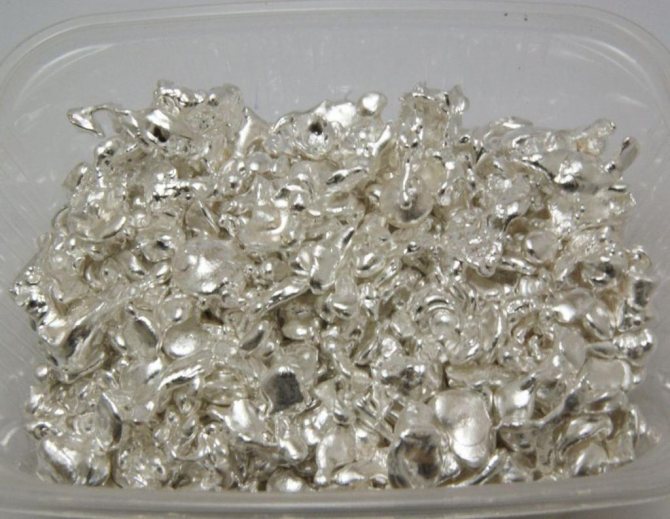
Removing silver from radio components
There are several ways by which you can extract silver contained in radio components: 1. A mixture consisting of sulfuric and nitric acid must be heated and the silver-containing part must be lowered into it. After they react, the silver is restored with zinc dust or shavings. 2. Carefully acidify the electrolyte with a small dose of hydrochloric acid by lowering the part into it. After some time, you can see a white cheesy precipitate - this is silver chloride. It must be left for 24 hours, after which hydrochloric acid is added to the filtered solution. The resulting silver precipitate must be filtered, washed and dried. 3. If the part is coated with a thin layer of silver, then a solution of metal iodine and potassium iodide heated to 50 degrees Celsius is used for extraction.
If the part is in the case, then first you need to remove it and separate the contact part from it, and remove the silver elements with pliers. It is better to fuse all the resulting parts, as this will save time and effort.
There is a lot of silver in Soviet-made relays and microswitches. One relay contains up to 2-3 grams of almost pure silver.
Today, anyone can mine technical silver at home, which, in principle, is what many people do, since this does not require special skills or high costs. It is worth noting that the price of silver is lower than that of gold, but its scope of application is much wider. And this suggests that it is easier to obtain secondary raw materials containing this noble metal, and accordingly, the profit from it will be much greater.
What are the differences from jewelry?
What is technical silver and what is the fundamental difference between these two types of metal? The differences are minor, but they are there:
- The first obvious difference is the scope of its application: jewelry silver is used for making jewelry, technical silver is used for industrial purposes.
- The requirement for technical silver is that the alloy must achieve the required physical characteristics for a specific application: resistance, thermal conductivity, etc. In a metal used in jewelry, appearance, wear resistance, and the ability to create complex jewelry play a role.
- Pure silver is often used in radio electronics and technology, but jewelers never use it because it is too soft.
Where is it used? Silver has a very wide range of applications. In addition to jewelry, it can be found in dentistry, medicine, and the production of coins and awards. The largest use of silver is in industry:
- It is used in electrical engineering in the manufacture of batteries, wires, coating of radio components, and contacts.
- In electronic technology, silver is used for soldering coatings, making solders, contact conductors, and more.
- The metal is also widely used in the food industry. It is used in equipment for preparing baby food.
Technical silver can be called two types of metal:
- silver used in industry;
- secondary, obtained by recycling devices that have become unusable.
In the USSR, devices very often contained radioelements containing precious metals. Therefore, in each passport for the device, data on their availability and weight were indicated. At each enterprise there was a special service that, when decommissioning a device before it was sent for scrap, had to remove all elements containing precious metals and send them for recycling.
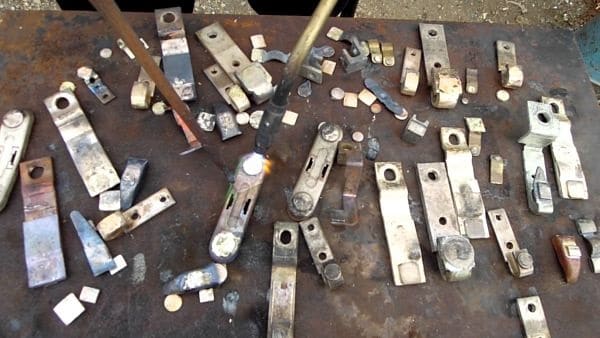
Technical silver
Once the scrap silver was recovered and processed, it could have different compositions depending on specific needs. The composition of such alloys was standardized, but did not correspond to jewelry samples. After this, the alloys were sent to refineries.
Pure silver can be used in production, but it is often used in the form of alloys. Therefore, the price of such silver will differ. There are several dozen standards, GOSTs, by which the alloys of silver used are determined.
Technical silver sample
The exact hallmark depends on the type and function of the silver:
- Magnetic . Used in switches, contact plates. The purity of silver is at the level of 60-65%, which corresponds to a sample of 600-650.
- Non-magnetic . Much purer silver, reaching 80%, or 800 purity. Most often, radio components are purchased for precisely this precious metal. The close proximity to jewelry grade 875 makes the silver suitable for melting down.
Galvanic coating deserves special attention. Often, the purchase of radio components is done for the sake of extracting this metal, which is exclusively 999-grade. The problem is the size. The film thickness is only a few microns, which is a thousand times less than one millimeter.
How to remove
The first step is to determine where exactly the silver is. Then you should take out the wire cutters and carefully separate the sections from the main part. Cleaning at home is extremely difficult. The reason is the toxicity of the reagents. Therefore, we have an extremely negative attitude towards refining “at home” and recommend that you not do it yourself.
The purification technology consists of dissolving the raw material in acid, after which it will need to be restored from chloride. The result will be metal of 980 standard. Additionally, you can use the electrolytic purification method to obtain almost pure silver.
You can profitably sell technical silver of any percentage in our company. For additional information, please contact our consultants by phone or in person.
Feel like a chemist
Do you want to continue experimenting? Every self-respecting jewelry store sells a kit for performing a chemical test. Before you begin unsealing reagents and chemicals, you should wear gloves. How is testing carried out?
- Scratch the product.
- Spread the acid over this area.
To correctly interpret test results, please read the instructions. The precious metal under the felting of chemical compounds will turn bright red. If there is a blue or brown tint, then silver is out of the question.
One of the ways to determine technical silver is clearly shown in the video:
If there is no opportunity or desire to test a product for “purity,” buy jewelry in trusted jewelry stores and avoid private traders who offer expensive goods at a cheap price.
Silver prices in 2021
Prices depend on the grade of metal. For 2021, the following price per gram of technical silver has developed in the Russian Federation:
- 750th sample - from 20 to 21 rubles;
- 800th sample - from 21 to 22.5 rubles;
- 875th sample - from 23 to 25 rubles;
- 900th sample - from 24 to 26 rubles;
- 925th standard from 25 to 26 rubles;
- 999th sample from 30 to 32 rubles.
Prices may vary depending on the discount price set by the Central Bank of the Russian Federation.
When selling metal in quantities of more than one kilogram, prices are higher than for technical silver per 1 gram, sold in smaller volumes.
